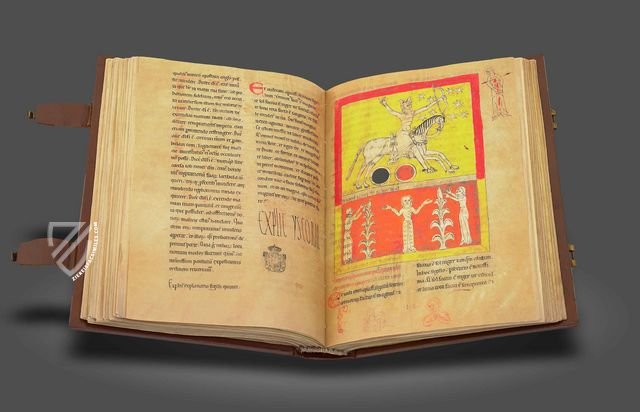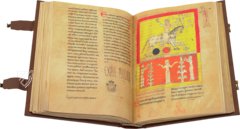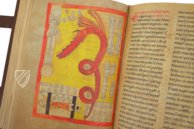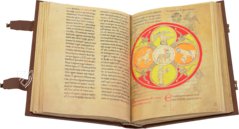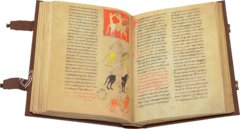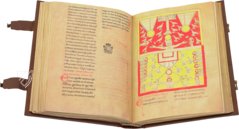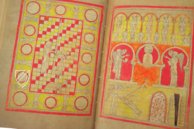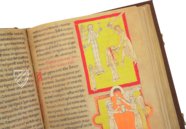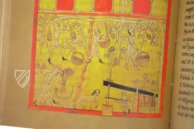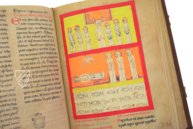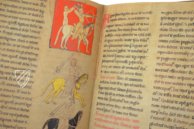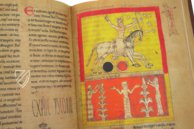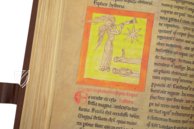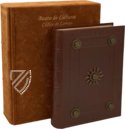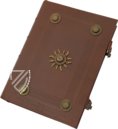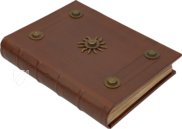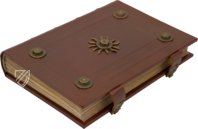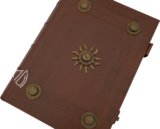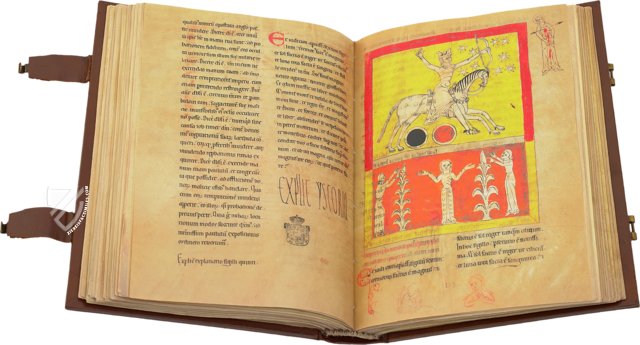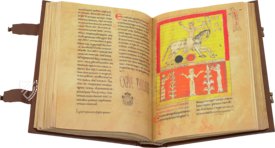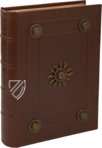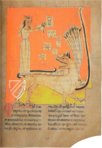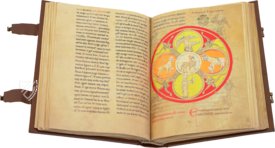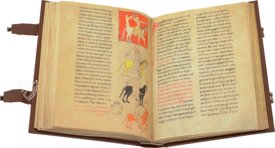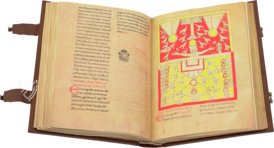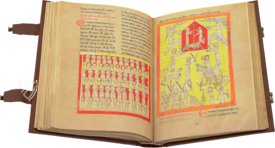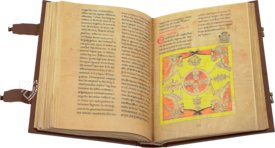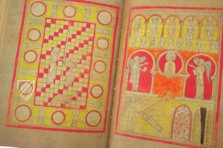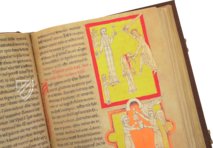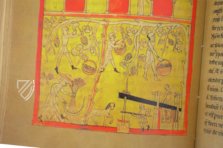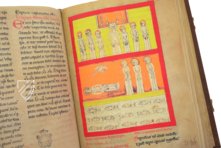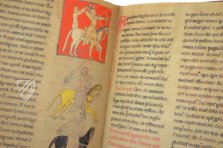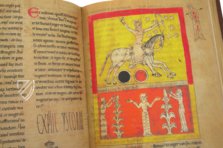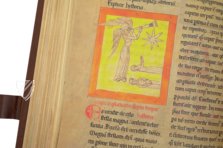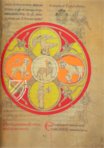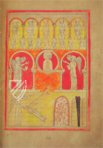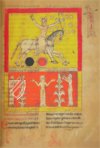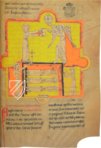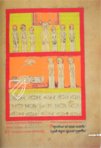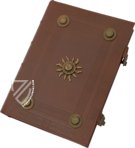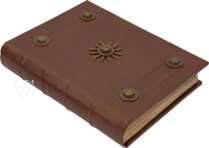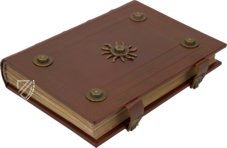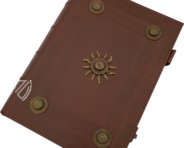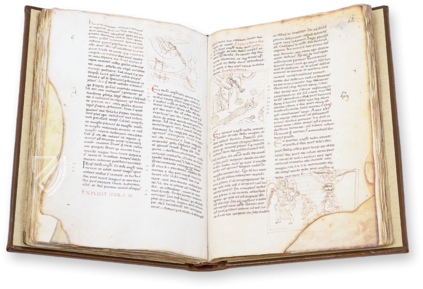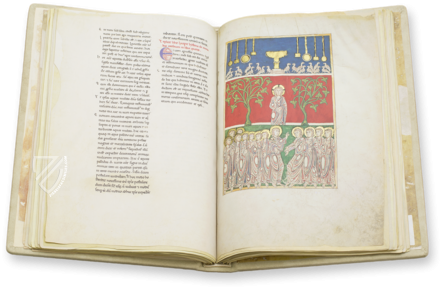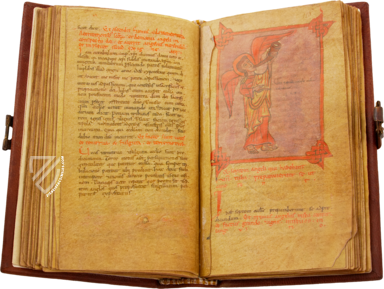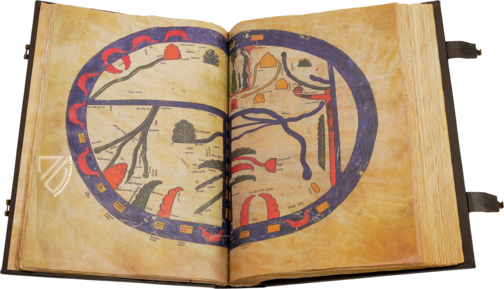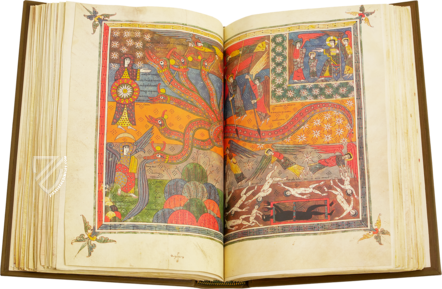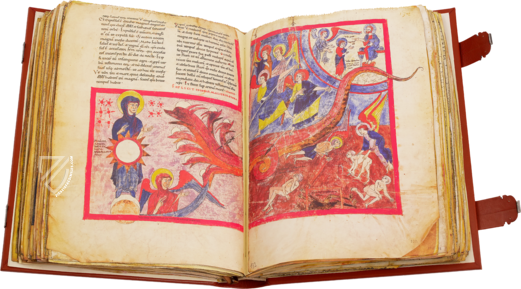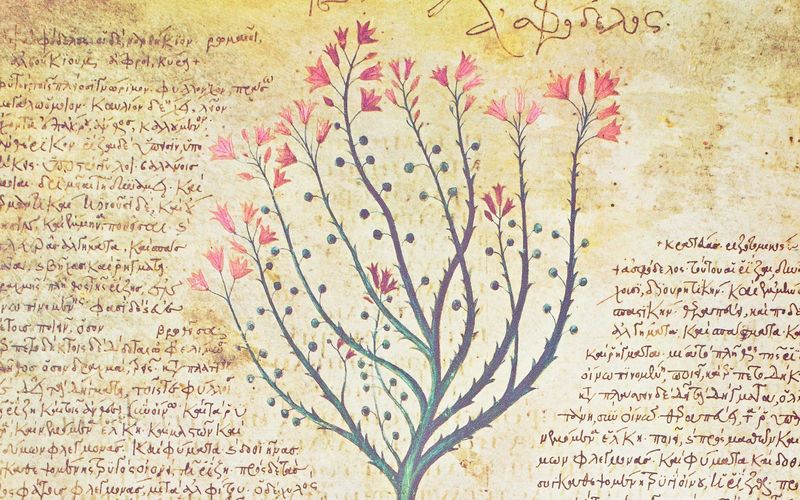Beatus of Liébana - Lorvao Codex
(3,000€ - 7,000€)
The so-called Lorvao Codex belongs among the collection of Beatus-Manuscripts, which are grandiose illustrations of the Apocalypse-Commentary of Beatus of Liébana. What is unique about this manuscript is that, unlike the majority of the well-known Beatus-Manuscripts, it was created in Portugal in 1189, not in Northern Spain. 88 large panel miniatures in 460 pages show the shock and awe of the Revelation of John concerning the end of the world. The biblical text and the adjoining commentary from Beatus is artfully illustrated in this manner.
Beatus of Liébana – Lorvao Codex
The so-called Lorvao Codex belongs among the collection of Beatus-Manuscripts, which are grandiose illustrations of the Apocalypse-Commentary of Beatus of Liébana. What is unique about this manuscript is that, unlike the majority of the well-known Beatus-Manuscripts, it was created in Portugal in 1189, not in Northern Spain. 88 large panel miniatures in 460 pages show the shock and awe of the Revelation of John concerning the end of the world. The biblical text and the adjoining commentary from Beatus is artfully illustrated in this manner.
A Great Work of Beatus of Liébana
This master work by the Asturian monk Beatus of Liébana was widely known in the Middles Ages originated in Northern Spain. Beatus of Liébana was a monk and theologian in a monastery in the Kingdom of Asturias in Northern Spain. He lived in the 8th century and died just after 798. He became well known through his work, the Commentary on the Book of Revelation. In his work Beatus, included staggered sections from different authors, and even cites many of his sources in the text. The text concerning the apocalypse is cut into 66 sections, which is immediately followed by a so-called explanation, a commentary from Beatus about the verses. The allegorical and symbolic pictures of the Apocalypse of John concerning the end of the world have been made more easily understandable. The year 800 was expected by many to be the End of the World, which prompted Beatus to create his now-well-established Apocalypse-Commentary.
An Extraordinary Example
This end of the 8th century script experienced great success, it was widely disseminated throughout Northern Spain in the Middle Ages and is found today in 27 richly illustrated manuscripts. They were likely not used for literary applications, but rather served as private prayer books or as luxury items and status symbols. These so-called Beatus-Manuscripts of the 10th through 12th centuries are counted amongst the masterpieces of Spanish book art. These examples derive almost exclusively from Northern Spain, which makes the Lorvao Codex a true anomaly, as it was created in Portugal. Written in 1189 in the MOnastery of São Mamede de Lorvão of Coimbra, the Lorvao Beatus belongs among the earliest Portuguese illuminated manuscripts. Perhaps connections can be made between the text and King Sancho I, who was the second King of Portugal. Today, the manuscript is housed within the Arquivo Nacional da Torre do Tombo in Lisbon.
Stylistically Distinguished Miniatures
88 partial and whole-page miniatures are distributed throughout the 460 pages. The manuscript is in a very large 34,5 x 24,5 cm format, which offers sufficient space for large pictures. Even the style of the miniatures of the Lorvao-Codex shows a special feature. Unlike the typical completely colored illustrations in most manuscripts, in this work colored miniatures of figures and objects are juxtaposed with uncolored items. In this way, they stand out strikingly from the basis of the images. The extreme stylization of bright colors predominates the imagery. The yellow and red tones of the miniatures are also outstanding features that are particularly striking. Among the many depictions are, for example, a scene of divine appearance, terrible visions of the apocalypse, but also ornamental picture pages illustrating the Apocalypse text and commentary. Wonderful iconographic pictures are also found within, which lend the script grandness and opulence. Regarding the scribe, a certain Egeas has been identified, who was also possibly responsible for the illustrations as well. The Lorvao Beatus manuscript counts as the earliest highpoint of Portuguese manuscript art. The commentary by Beatus of Liébana of the Apocalypse of John that one finds within is creative and entertaining and of an extremely high artistic quality. Above all, the Lorvao-Codex is a distinguished example of the important (North Spanish) tradition of Beatus-Manuscripts of the 10th through 12th centuries.
Codicology
- Alternative Titles
- Lorvao Beatus
Beato de Liébana: Códice de Lorvao
Beato di Liébana. Codice di Lorvao - Size / Format
- 460 pages / 34.5 × 24.5 cm
- Origin
- Portugal
- Date
- 1189
- Epochs
- Style
- Genre
- Illustrations
- 88 miniatures
- Artist / School
- Beatus of Liébana (died after 798) (author)
Beatus of Liébana – Lorvao Codex
The Seven Trumpets
A classic example of the Beatus tradition with radiant colors, expressive figures, and clean lines. “When He opened the seventh seal, there was silence in heaven for about half an hour. And I saw the seven angels who stand before God, and to them were given seven trumpets. Then another angel, having a golden censer, came and stood at the altar. He was given much incense, that he should offer it with the prayers of all the saints upon the golden altar which was before the throne.” (Rev. 8:1-3)
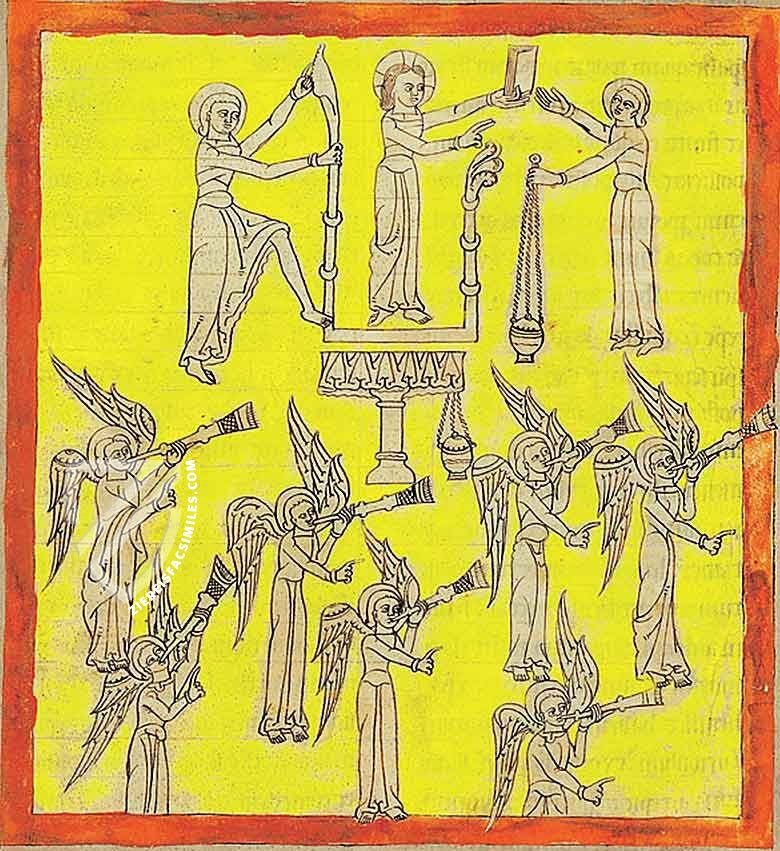
Beatus of Liébana – Lorvao Codex
The First Horseman and the Great Earthquake
Among the most important symbols of the Book of Revelation are the Seven Seals, which secure the scroll seen by John of Patmos. The First and Sixth Seals are combined here: the First Horseman of the Apocalypse rides out, bow in hand, and beneath him the events of the great earthquake are depicted, “…the sun became black as sackcloth of hair, and the moon became like blood” (Rev. 6:12).
Although this is the only Portuguese Beatus manuscript, it nonetheless retains the aesthetic typical of these Iberian manuscripts up to this time: thick strokes of black and a color palette dominated by red, orange, and yellow. Although the miniature is likely based on older, outdated forms, the text and marginalia reveal a more advanced and refined hand.
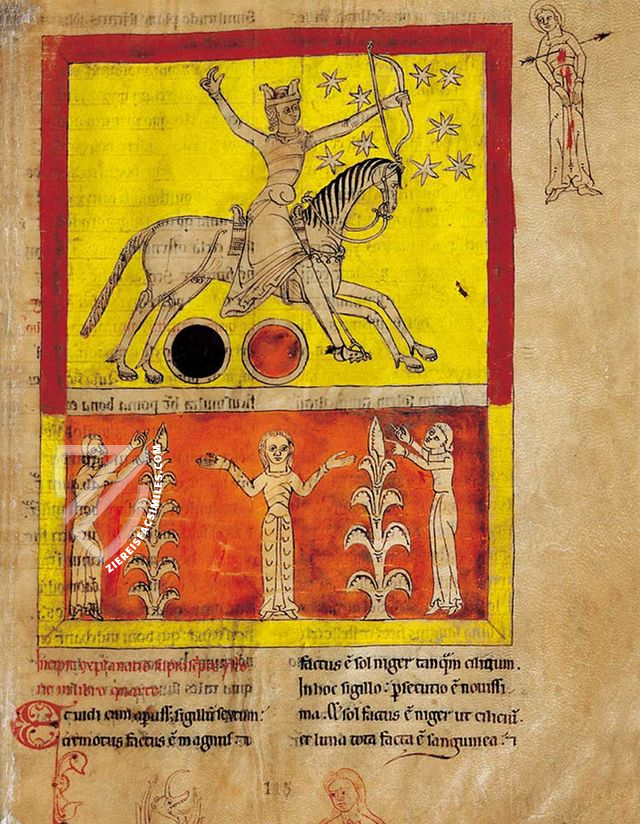
#1 Beato de Liébana: Códice de Lorvao
Languages: Spanish, English
(3,000€ - 7,000€)
- Treatises / Secular Books
- Apocalypses / Beatus
- Astronomy / Astrology
- Bestiaries
- Bibles / Gospels
- Chronicles / History / Law
- Geography / Maps
- Saints' Lives
- Islam / Oriental
- Judaism / Hebrew
- Single Leaf Collections
- Leonardo da Vinci
- Literature / Poetry
- Liturgical Manuscripts
- Medicine / Botany / Alchemy
- Music
- Mythology / Prophecies
- Psalters
- Other Religious Books
- Games / Hunting
- Private Devotion Books
- Other Genres
- Afghanistan
- Armenia
- Austria
- Belgium
- Belize
- Bosnia and Herzegovina
- China
- Colombia
- Costa Rica
- Croatia
- Cyprus
- Czech Republic
- Denmark
- Egypt
- El Salvador
- Ethiopia
- France
- Germany
- Greece
- Guatemala
- Honduras
- Hungary
- India
- Iran
- Iraq
- Israel
- Italy
- Japan
- Jordan
- Kazakhstan
- Kyrgyzstan
- Lebanon
- Liechtenstein
- Luxembourg
- Mexico
- Morocco
- Netherlands
- Palestine
- Panama
- Peru
- Poland
- Portugal
- Romania
- Russia
- Serbia
- Spain
- Sri Lanka
- Sweden
- Switzerland
- Syria
- Tajikistan
- Turkey
- Turkmenistan
- Ukraine
- United Kingdom
- United States
- Uzbekistan
- Vatican City
- A. Oosthoek, van Holkema & Warendorf
- Aboca Museum
- Ajuntament de Valencia
- Akademie Verlag
- Akademische Druck- u. Verlagsanstalt (ADEVA)
- Aldo Ausilio Editore - Bottega d’Erasmo
- Alecto Historical Editions
- Alkuin Verlag
- Almqvist & Wiksell
- Amilcare Pizzi
- Andreas & Andreas Verlagsbuchhandlung
- Archa 90
- Archiv Verlag
- Archivi Edizioni
- Arnold Verlag
- ARS
- Ars Magna
- ArtCodex
- AyN Ediciones
- Azimuth Editions
- Badenia Verlag
- Bärenreiter-Verlag
- Belser Verlag
- Belser Verlag / WK Wertkontor
- Benziger Verlag
- Bernardinum Wydawnictwo
- BiblioGemma
- Biblioteca Apostolica Vaticana (Vaticanstadt, Vaticanstadt)
- Bibliotheca Palatina Faksimile Verlag
- Bibliotheca Rara
- Boydell & Brewer
- Bramante Edizioni
- Bredius Genootschap
- Brepols Publishers
- British Library
- C. Weckesser
- Caixa Catalunya
- Canesi
- CAPSA, Ars Scriptoria
- Caratzas Brothers, Publishers
- Carus Verlag
- Casamassima Libri
- Centrum Cartographie Verlag GmbH
- Chavane Verlag
- Christian Brandstätter Verlag
- Circulo Cientifico
- Club Bibliófilo Versol
- Club du Livre
- CM Editores
- Collegium Graphicum
- Collezione Apocrifa Da Vinci
- Comissão Nacional para as Comemorações dos Descobrimentos Portugueses
- Coron Verlag
- Corvina
- CTHS
- D. S. Brewer
- Damon
- De Agostini/UTET
- De Nederlandsche Boekhandel
- De Schutter
- Deuschle & Stemmle
- Deutscher Verlag für Kunstwissenschaft
- DIAMM
- Droz
- E. Schreiber Graphische Kunstanstalten
- Ediciones Boreal
- Ediciones Grial
- Ediclube
- Edições Inapa
- Edilan
- Editalia
- Edition Deuschle
- Edition Georg Popp
- Edition Leipzig
- Edition Libri Illustri
- Editiones Reales Sitios S. L.
- Éditions de l'Oiseau Lyre
- Editions Medicina Rara
- Editorial Casariego
- Editorial Mintzoa
- Editrice Antenore
- Editrice Velar
- Edizioni Edison
- Egeria, S.L.
- Eikon Editores
- Electa
- Emery Walker Limited
- Enciclopèdia Catalana
- Eos-Verlag
- Ephesus Publishing
- Ernst Battenberg
- Eugrammia Press
- Extraordinary Editions
- Fackelverlag
- Facsimila Art & Edition
- Facsimile Editions Ltd.
- Facsimilia Art & Edition Ebert KG
- Faksimile Verlag
- Feuermann Verlag
- Folger Shakespeare Library
- Franco Cosimo Panini Editore
- Friedrich Wittig Verlag
- Fundación Hullera Vasco-Leonesa
- G. Braziller
- Gabriele Mazzotta Editore
- Gebr. Mann Verlag
- Gesellschaft für graphische Industrie
- Getty Research Institute
- Giovanni Domenico de Rossi
- Giunti Editore
- Graffiti
- Grafica European Center of Fine Arts
- Guido Pressler
- Guillermo Blazquez
- Gustav Kiepenheuer
- H. N. Abrams
- Harrassowitz
- Harvard University Press
- Helikon
- Hendrickson Publishers
- Henning Oppermann
- Herder Verlag
- Hes & De Graaf Publishers
- Hoepli
- Holbein-Verlag
- Houghton Library
- Hugo Schmidt Verlag
- Idion Verlag
- Il Bulino, edizioni d'arte
- ILte
- Imago
- Insel Verlag
- Insel-Verlag Anton Kippenberger
- Instituto de Estudios Altoaragoneses
- Instituto Nacional de Antropología e Historia
- Introligatornia Budnik Jerzy
- Istituto dell'Enciclopedia Italiana - Treccani
- Istituto Ellenico di Studi Bizantini e Postbizantini
- Istituto Geografico De Agostini
- Istituto Poligrafico e Zecca dello Stato
- Italarte Art Establishments
- Jan Thorbecke Verlag
- Johnson Reprint Corporation
- Josef Stocker
- Josef Stocker-Schmid
- Jugoslavija
- Karl W. Hiersemann
- Kasper Straube
- Kaydeda Ediciones
- Kindler Verlag / Coron Verlag
- Kodansha International Ltd.
- Konrad Kölbl Verlag
- Kurt Wolff Verlag
- La Liberia dello Stato
- La Linea Editrice
- La Meta Editore
- Lambert Schneider
- Landeskreditbank Baden-Württemberg
- Leo S. Olschki
- Les Incunables
- Liber Artis
- Library of Congress
- Libreria Musicale Italiana
- Lichtdruck
- Lito Immagine Editore
- Lumen Artis
- Lund Humphries
- M. Moleiro Editor
- Maison des Sciences de l'homme et de la société de Poitiers
- Manuscriptum
- Martinus Nijhoff
- Maruzen-Yushodo Co. Ltd.
- MASA
- Massada Publishers
- McGraw-Hill
- Metropolitan Museum of Art
- Militos
- Millennium Liber
- Müller & Schindler
- Nahar - Stavit
- Nahar and Steimatzky
- National Library of Wales
- Neri Pozza
- Nova Charta
- Oceanum Verlag
- Odeon
- Orbis Mediaevalis
- Orbis Pictus
- Österreichische Staatsdruckerei
- Oxford University Press
- Pageant Books
- Parzellers Buchverlag
- Patrimonio Ediciones
- Pattloch Verlag
- PIAF
- Pieper Verlag
- Plon-Nourrit et cie
- Poligrafiche Bolis
- Presses Universitaires de Strasbourg
- Prestel Verlag
- Princeton University Press
- Prisma Verlag
- Priuli & Verlucca, editori
- Pro Sport Verlag
- Propyläen Verlag
- Pytheas Books
- Quaternio Verlag Luzern
- Reales Sitios
- Recht-Verlag
- Reichert Verlag
- Reichsdruckerei
- Reprint Verlag
- Riehn & Reusch
- Roberto Vattori Editore
- Rosenkilde and Bagger
- Roxburghe Club
- Salerno Editrice
- Saltellus Press
- Sandoz
- Sarajevo Svjetlost
- Schöck ArtPrint Kft.
- Schulsinger Brothers
- Scolar Press
- Scrinium
- Scripta Maneant
- Scriptorium
- Shazar
- Siloé, arte y bibliofilia
- SISMEL - Edizioni del Galluzzo
- Sociedad Mexicana de Antropología
- Société des Bibliophiles & Iconophiles de Belgique
- Soncin Publishing
- Sorli Ediciones
- Stainer and Bell
- Studer
- Styria Verlag
- Sumptibus Pragopress
- Szegedi Tudomànyegyetem
- Taberna Libraria
- Tarshish Books
- Taschen
- Tempus Libri
- Testimonio Compañía Editorial
- Thames and Hudson
- The Clear Vue Publishing Partnership Limited
- The Facsimile Codex
- The Folio Society
- The Marquess of Normanby
- The Richard III and Yorkist History Trust
- Tip.Le.Co
- TouchArt
- TREC Publishing House
- TRI Publishing Co.
- Trident Editore
- Tuliba Collection
- Typis Regiae Officinae Polygraphicae
- Union Verlag Berlin
- Universidad de Granada
- University of California Press
- University of Chicago Press
- Urs Graf
- Vallecchi
- Van Wijnen
- VCH, Acta Humaniora
- VDI Verlag
- VEB Deutscher Verlag für Musik
- Verlag Anton Pustet / Andreas Verlag
- Verlag Bibliophile Drucke Josef Stocker
- Verlag der Münchner Drucke
- Verlag für Regionalgeschichte
- Verlag Styria
- Vicent Garcia Editores
- W. Turnowski Ltd.
- W. Turnowsky
- Waanders Printers
- Wiener Mechitharisten-Congregation (Wien, Österreich)
- Wissenschaftliche Buchgesellschaft
- Wissenschaftliche Verlagsgesellschaft
- Wydawnictwo Dolnoslaskie
- Xuntanza Editorial
- Zakład Narodowy
- Zollikofer AG

